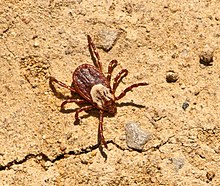Dermacentor
| Dermacentor Temporal range:
| |
|---|---|

| |
| Dermacentor occidentalis | |
| Scientific classification | |
| Kingdom: | |
| Phylum: | |
| Class: | |
| Subclass: | Acari |
| Superorder: | |
| Order: | |
| Family: | |
| Genus: | Dermacentor |
| Type species | |
| Dermacentor reticulatus (Fabricius, 1794)
| |
| Synonyms | |
| |
Dermacentor is a genus of ticks in the family Ixodidae, the hard ticks. The genus has a cosmopolitan distribution, with native species on all continents except Australia. Most are found in North America.[2]
Hosts of Dermacentor ticks include many large and small mammals, including horses, deer, cattle, lagomorphs, peccaries, porcupines, tapirs, desert bighorn sheep, and humans.[2] The American dog tick (D. variabilis) is a member of the genus.[3]
Dermacentor species are
vectors of many pathogens, including Rickettsia rickettsii, which causes the disease Rocky Mountain spotted fever, Coxiella burnetii, which causes Q fever, Anaplasma marginale, which causes anaplasmosis in cattle, Francisella tularensis, which causes tularemia, Babesia caballi, which causes equine piroplasmosis, and the Flavivirus that causes Powassan encephalitis.[2] Dermacentor ticks inject a neurotoxin that causes tick paralysis.[2]
Species
As of 2019, about 41 species are placed in the genus:
- Dermacentor abaensis Teng, 1963
- Dermacentor albipictus Packard, 1869 – winter tick
- Dermacentor andersoni Stiles, 1908 – Rocky Mountain wood tick
- Dermacentor asper Arthur, 1960
- Dermacentor atrosignatus Neumann, 1906
- Dermacentor auratus Supino, 1897
- Dermacentor bellulus Schulze, 1933
- Dermacentor circumguttatus Neumann, 1897
- Dermacentor compactus Neumann, 1901
- Dermacentor confragus Schulze, 1933
- Dermacentor dispar Cooley, 1937
- Dermacentor dissimilis Cooley, 1947
- Dermacentor everestianus Hirst, 1926
- Dermacentor filippovae Apanaskevich & Apanaskevich, 2015[4]
- Dermacentor halli McIntosh, 1931
- Dermacentor hunteri Bishopp, 1912
- Dermacentor imitans Warburton 1933
- Dermacentor kamshadalus Neumann, 1908[5]
- Dermacentor laothaiensis Apanaskevich et al., 2019[6]
- Dermacentor latus Cooley, 1937
- Dermacentor limbooliati Apanaskevich & Apanaskevich, 2015[7]
- Dermacentor marginatus Sulzer, 1776
- Dermacentor montanus Filippova & Panova, 1974
- Dermacentor nitens Neumann, 1897
- Dermacentor niveus Neumann 1897
- Dermacentor nuttalli Olenev, 1928
- Dermacentor occidentalis Marx, 1892 - Pacific Coast tick
- Dermacentor panamensis Apanaskevich & Bermúdez, 2013[8]
- Dermacentor parumapertus Neumann, 1901
- Dermacentor pasteuri Apanaskevich et al., 2020[9]
- Dermacentor pavlovskyi Olenev 1927
- Dermacentor pomerantzevi Serdyukova, 1951
- Dermacentor pseudocompactus Apanaskevich & Apanaskevich, 2016[10]
- Dermacentor raskemensis Pomerantsev, 1946
- Dermacentor reticulatus Fabricius, 1794 – ornate cow tick, ornate dog tick, meadow tick, marsh tick
- Dermacentor rhinocerinus Denny, 1843
- Dermacentor silvarum Olenev 1931
- Dermacentor sinicus Schulze, 1932
- Dermacentor steini Schulze, 1933
- Dermacentor taiwanensis Sugimoto, 1935
- Dermacentor tamokensis Apanaskevich & Apanaskevich, 2016[10]
- Dermacentor ushakovae Filippova & Panova 1987
- Dermacentor variabilis Say, 1821 – wood tick, American dog tick
References
- ^ Don R. Arthur (1960). "The genus Dermacentor: 1. General". The genera Dermacentor, Anocentor, Cosmiomma, Boophilus, Margaropus. Ticks. Vol. 5. Cambridge University Press. pp. 6–37.
- ^ a b c d C. E. Yunker; J. E. Keirans; C. M. Clifford; E. R. Easton (1986). "Dermacentor ticks (Acari: Ixodoidea: Ixodidae) of the New World: a scanning electron microscope atlas" (PDF). Proceedings of the Entomological Society of Washington. 88 (4): 609–627. Archived from the original (PDF) on 2013-10-29. Retrieved 2013-09-04.
- ^ W. Chen; P. E. Kaufman (2008). "American Dog Tick, Dermacentor variabilis (Say) (Arachnida: Ixodida: Ixodidae)". Entomology and Nematology. Florida Cooperative Extension Service. University of Florida Institute of Food and Agricultural Sciences. EENY-443. Retrieved December 4, 2013.
- PMID 26336207.
- ^ Dmitry A Apanaskevich, Stephen C Barker, Dermacentor kamshadalus (Acari: Ixodidae), a Tick of Mountain Goats and Sheep in Western United States, Canada, and Russia, Is a Valid Species, Journal of Medical Entomology, tjaa190, https://doi.org/10.1093/jme/tjaa190.
- S2CID 160013314.
- PMID 26336300.
- PMID 24843922.
- ^ Dmitry Apanaskevich, Khamsing Vongphayloth, Pattraporn Jeangkhwoa, Aummarin Chaloemthanetphong, Arunee Ahantarig, Maria Apanaskevich, Paul T. Brey, Khaithong Lakeomany, Wachareeporn Trinachartvanit. 2020. Description of a new species of Dermacentor Koch, 1844 (Acari: Ixodidae) from the mountains of Laos and Thailand. Systematic Parasitology, https://doi.org/10.1007/s11230-020-09916-6. Last accessed 11 Jun 2020.
- ^ a b Dmitry A. Apanaskevich and Maria A. Apanaskevich. 2016. Description of Two New Species of Dermacentor Koch, 1844 (Acari: Ixodidae) From Oriental Asia. Systematic Parasitology 2016 Feb;93(2):159-71. https://doi.org/10.1007/s11230-015-9614-8. Epub 2016 Jan 20.
External links
- S. J. Dergousoff; N. B. Chilton (2007). "Differentiation of three species of ixodid tick, Dermacentor andersoni, D. variabilis and D. albipictus, by PCR-based approaches using markers in ribosomal DNA". PMID 17544620.

